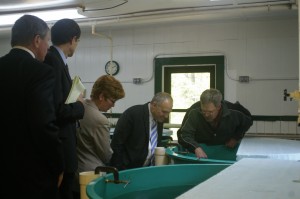
Dan Josephson of the fish ahtchery at the Adirondack League Club, right, observes a tank of fish eggs and fingerlings with New York State Comptroller Thomas DiNapoli and Adirondack Park Agency Chairwoman Lani Ulrich. Photo by Dana Armington
As part of his visit to the Central Adirondacks, Adirondack Landowners Association President Tom Williams invited New York State Comptroller Thomas DiNapoli to tour the Cornell Fish Hatchery to witness firsthand the efforts of public-private partnerships in the Adirondacks.
Heading the operation, which was first started by former Cornell University Professor, Doctor Mark Webster, are Cliff Kraft and Dan Josephson who are assisted by both graduate and undergraduate students as well as interns and seasonal employees.
For 60 years, participants in the Adirondack Fishery Research Program, through the Department of Natural Resources at Cornell University, have been collecting invaluable data on a variety of fish at the Little Moose Field House in the Adirondack League Club.And while the Little Moose Field Station may serve as their headquarters, Cornell’s Adirondack fisheries research efforts are conducted on both public and private waters throughout the state of New York, including cooperative investigations with the NYS Department of Environ-mental Conservation.
Through research conducted at the site and elsewhere they have investigated ecosystem processes in bodies of water throughout the Adirondacks with the goal of gathering information on salmonine fish including trout, char, and salmon; and what it takes to create and maintain self-sustaining wild populations.
“The basis of our research is the protection and management of the native fish communities and a subset of that is the recreational fisheries for Lake Trout and Brook Trout,” Josephson said to DiNapoili during his presentation.
“So, we frame our work around what impacts those native fisheries. That would include the introduction of non-native fish species, which are particularly bad when it comes to native fish disease; that can evolve without a lot of competition from fish and predators like bass and pike,” Josephson added.
While secondary to the fishery research, the program also investigates habitat issues that arise from climate change, acid rain, mercury contamination, human impact, invasive species,
On site, an indoor hatchery space is used for rearing eggs and fingerlings while an outdoor space holds ten circular tanks for rearing Brook Trout, Atlantic Salmon, and Round Whitefish.
In a normal year, the Fish Hatchery has an egg survival rate of seventy-five percent.
“We do more of a science-based management where we try to get to the underpinnings of the fisheries and why exactly are they performing, or not performing, the way we want them to so that we are not wasting resources,” Cliff said of their research.
According to Josephson and Kraft, one of the benefits to their partnership with the League Club is their ability to conduct long-term controlled studies that can provide immeasurable data over a period of decades.
This, they said, helps them to get to the core of what can sustain a population, and puts them ahead of the game in terms of environmental management, maintaining wild populations, and doing the right thing.
In addition to their research, the Cornell Fish Hatchery is also responsible for many of the fish that get stocked into lakes and ponds throughout the region and the state, as well as for removing harmful non-native species and protecting the endangered fish that live in seven Adirondack lakes.
“The trout that get stocked in New York by the DEC are a hybrid brook trout whose science was developed here,” Williams told DiNapoli.
“And one of the reasons that you are here today is because the average sportsman, the guy who buys the license and buys the container of worms to go fishing here has no idea that the fisheries are a result of this public-private partnership that’s been benefiting the public for fifty to sixty years.”
Over the years, the Adirondacks have seen a drop in native fish populations, however, through the work of private partnerships like the Cornell Fish Hatchery at the ALC, brook trout and lake trout, amongst others, are making a comeback.
“Part of our message is: don’t give up on brook trout, don’t give up on lake trout, don’t give up on the endangered brown white heads,” Kraft said.
“Do we have concerns about brook trout? Yes. But are they gone? No. And if anything, it’s getting better.”
Following his visit to the Adirondack League Club, Comptroller DiNapoli met with area officials and group leaders at View. During the discussions with the audience, DiNapoli spoke of his visit to the hatchery and to Old Forge.
“The wonderful relationship that we saw first hand between the club and Cornell, and the research that is being done there at the hatchery benefits not only those of us who are recreational fishermen and women in this part of the state; but really, all across our state,” he said.
